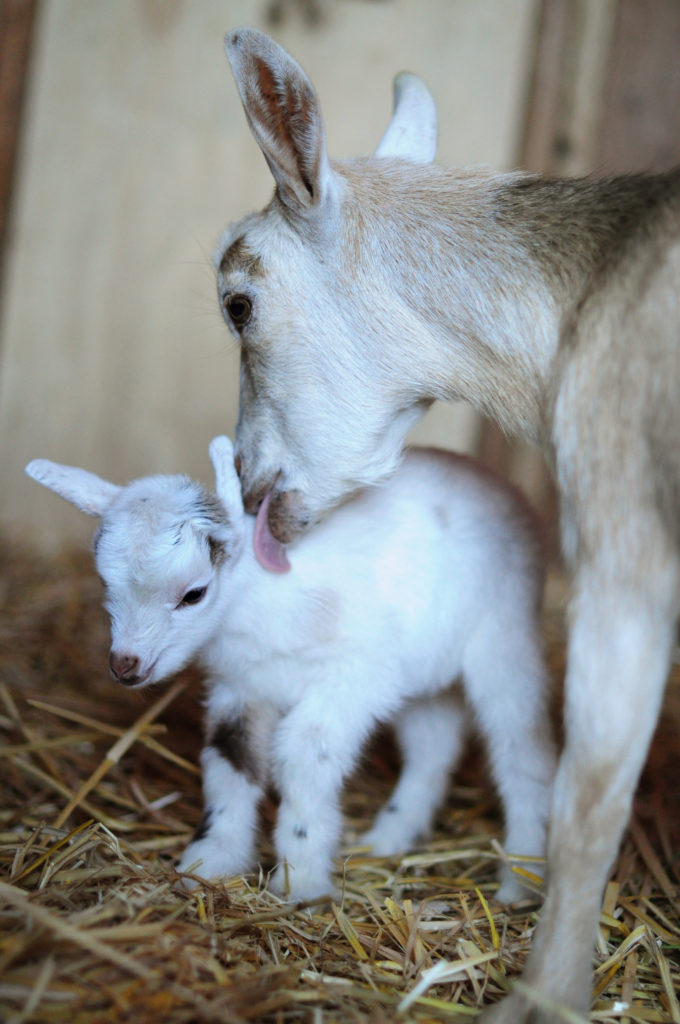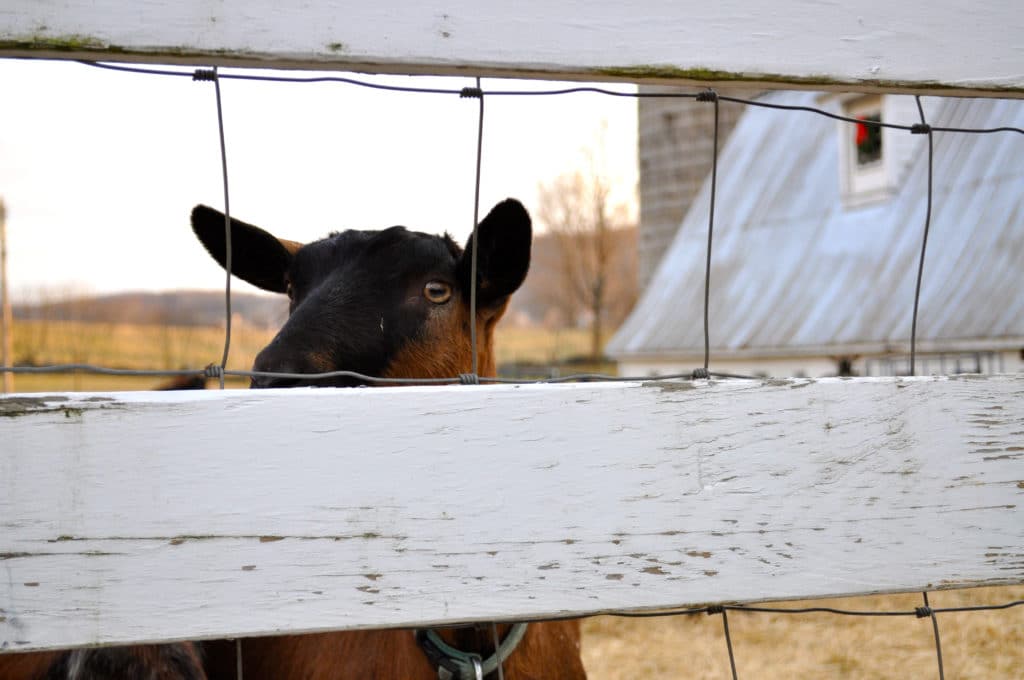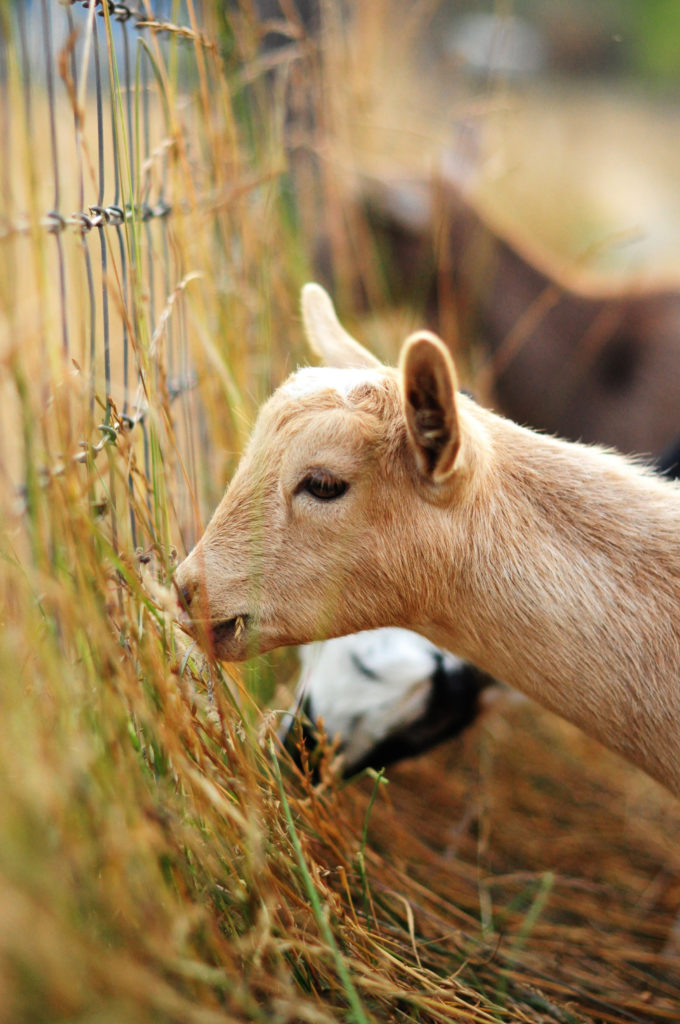The Education of a Beginning Goat Farmer

A first time mom gets to know her new baby. Photo by Stephanie Fisher.
I spent most of 2011 working and living in Brooklyn, NY with my boyfriend. I manned phones and servers in the semi-glamorous world of mail-order meat, while he managed an independent ice cream store in mid-town. We were trying our luck at post-graduate success, although it seemed our luck was running out; the effects of the constant adrenaline that come with living in a bustling metropolis were beginning to show, and we were searching for a way out of the grind.
We were introduced to a pair of Vermont dairy goat farmers at a function for my job. We were somewhat in awe of the young, handsome couple, especially since their farm held a highly regarded reputation in New York City. In between the usual small talk, I mentioned that my boyfriend and I had dreams of working in agriculture, and even of owning our own farm. We exchanged contact information as a formality and then parted ways.
Three months went by before the farmers contacted us about an upcoming internship opportunity. I struggled with the decision, having been offered a second year at my company, with a hefty salary as bait. I wasn’t even a year out of college and already I was turning down a desirable position at a somewhat trendy organization in one of the toughest cities in America. While all of our friends were trudging their way along career-oriented paths, I couldn’t help but feel like I was stalling-out, moving farther away from the elusive job security that my university degree is supposed to guarantee. But we couldn’t say no.
After various email exchanges, two-week notices, a lease cancellation, and many bittersweet good-byes to close friends, we found ourselves and our packed car in a tiny village in eastern Vermont where we would live for the next two months as the farm’s kidding interns.
We lived about a mile from the farm on the second story of an old fish and game building downtown. This, of course, defies all known definitions of downtown. Our building was among only a few others, including a firehouse across the street that sponsored monthly pancake breakfasts. Besides us, the fish and game also housed the weekly farmers market, where local vendors would sell hot food, fresh meats, and handmade goods. Practically the entire village would show up for the weekly meet-up; it was a foreign but welcome sensation to recognize every face in the room.
Although the first doe wasn’t due for another week, I was eager to work my desk-jockey exhaustion away. That’s why we left the city in the first place, to connect with something real and physical, something that mattered and made a difference beyond small-batch artisan ice cream and customer service. But instead of the never-ending lifting, bending, and cleaning that I had imagined farm work would be, we spent a lot of time discussing and observing. (I was so consumed by this preconceived notion that I made a point to mention my small stature and presupposed inability to lift fifty pounds in every farm-job interview we had.) The famers showed us their endless record keeping system, their precise farm procedures, their business plans and grant proposals – all things familiar to me after working the previous four years in administration.
We lived about a mile from the farm on the second story of an old fish and game building downtown. This, of course, defies all known definitions of downtown. Our building was among only a few others, including a firehouse across the street that sponsored monthly pancake breakfasts. Besides us, the fish and game also housed the weekly farmers market, where local vendors would sell hot food, fresh meats, and handmade goods. Practically the entire village would show up for the weekly meet-up; it was a foreign but welcome sensation to recognize every face in the room.

A curious doe takes a peak. Photo by Stephanie Fisher.
Although the first doe wasn’t due for another week, I was eager to work my desk-jockey exhaustion away. That’s why we left the city in the first place, to connect with something real and physical, something that mattered and made a difference beyond small-batch artisan ice cream and customer service. But instead of the never-ending lifting, bending, and cleaning that I had imagined farm work would be, we spent a lot of time discussing and observing. (I was so consumed by this preconceived notion that I made a point to mention my small stature and presupposed inability to lift fifty pounds in every farm-job interview we had.) The famers showed us their endless record keeping system, their precise farm procedures, their business plans and grant proposals – all things familiar to me after working the previous four years in administration.
After saying our morning hellos, the two of us would head to the separate kidding barn where we were greeted by the deafening bleats of around 100 baby goats. All of the kids would be jumping and bouncing with uncontainable excitement at the sight of us. We had to rush into the pens with their milk buckets or risk being trampled by their tiny, unruly bodies. They would grab onto anything they could and attempt to draw-out milk: fingers, zippers, shoelaces, ear lobes… In about an hour and a half’s time, the barn would be nearly silent as the kids’ bellies were filled and they would begin to cuddle-up for their post-breakfast naps. At the end of the morning, we’d survey the furry, vibrating mounds, every kid fitting just so perfectly into their respective piles like pieces of live jig-saw puzzles.
The babies never ceased to be cute and amusing, but the farmers warned us about the sometimes-morbid nature of dairy farming. “Where there is livestock, there is deadstock.” Having worked for a meat reseller and butcher shop, I had seen my fair share of slaughterhouses and animal carcasses, so I thought myself well prepared for my new industry. But of course I remember my first kid death, and it was nothing like slicing deli ham.
A three-week old kid had aspirated milk into her lungs. We found the tiny doe listless, her breathing labored and temperature below normal. She was clearly beyond help, and began to fade in the farmer’s arms. She let out three painful, desperate cries, each beginning quietly and ending in a hollow crescendo. The farmers identified them as the “death cries.” Shortly after, her breathing stopped. I couldn’t believe I watched the literal life of this animal disappear into the ether right there in the barn. That wouldn’t be the last time we’d hear those unmistakable cries; we’d witness plenty more goat deaths over the next year. Just as the farmer’s warned, there will always be deadstock, try as you might to save every animal.
Our internship came to an end in late April, just as the days were beginning to thaw. We ceremoniously packed up our car and once again said bittersweet goodbyes. We coordinated jobs at a start-up goat dairy in Washington and pushed ourselves through another instantaneous transition to living on the West Coast. Our education as goat farmers continued.

A four-month-old doeling nibbles in the grass. Photo by Stephanie Fisher.
We returned to the East Coast in a year’s time, and things remained largely as we left them. Our friends were continuing their climbs up their respective career ladders, our favorite bars were still overcharging for beers. Although we were effectively unemployed for twelve months, we managed to live in two different states and drove our car across the country twice, adding nearly 20,000 miles to the odometer (this of course doesn’t account for the infinite miles we added to our autobiographical till).
Our financial chips were down, but we had promise in our future as we returned to the same Vermont farm where we started, not as interns, but as employees. We’re pleased to be making a wage, but we’re also grateful to continue working in a job that exhilarates us every day. All the decisions I made throughout college were safe – relevant internship after relevant internship – steering me toward an indefinable goal. Farming seemed like a complete departure from everything sensible, but it was just an unexpected detour. Like most things in life, farming is an indescribable combination of applied knowledge, intuition, and luck.


How can i start my own goat farm i also live in Brooklyn, NY and i really want to start a goat farm
Hi Sayed,
I would recommend reaching out to your local Cornell Cooperative Extension contact:
Sam Anderson
Urban Agriculture Specialist, Harvest NY
55 Hanson Place, Suite 350
Brooklyn, NY 11217
swa39@cornell.edu
781-366-5939
Thanx for sharing your experience that will help me as a beginner goat farmer
Thanks for this info. I would like to get into Goat Farming so I am reading anything I can find. Jshivprashad@hotmail.com.